The R/V Thomas G. Thompson left Honolulu on November 5, 2011 heading toward the Western Pacific. This expedition journal was written by cruise participants and uploaded about once per weekday, depending on internet availability.
December 13, 2011: AB See, Dani Do
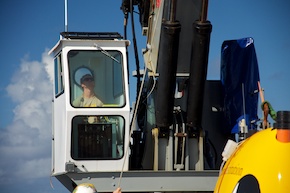
Carlos operates the crane (Credit: Will Koeppen)
We humans have a habit of repeating what we see seen others do, a learning tool that many of us do not realize we use on a regular basis. Think back to a time when you watched your parents working in the kitchen and picked up on how they made a certain dish, or when you got into trouble at home for repeating a not-so-appropriate word you heard from someone else. We learn best from others’ examples, and because of this job shadowing has become an effective way of learning new skills. I remember following my dad around the garage when I was younger, learning about the numerous tools on the wall and how he used them to fix various things. Busy hands and a short attention span prevented me from being the best dad-shadow, since I had a habit of misplacing his tools as well as getting grease all over my clothes. But I believe that over the years I have honed my shadowing skills, and I tried using them to learn from the able seamen (ABs) on board.
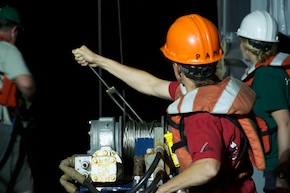
Pam helps deploy seismics (Credit:Will Koeppen)
The first challenge I encountered during my shadowing experience was finding an AB that I could follow without getting in their way during a time when I wasn’t on watch at my station. The task was even more difficult because ABs rarely stay in one place for long periods of time, moving from one task to another all over the ship. Luckily, I had a habit of running into a few of the ABs in the morning during my cereal bowl run and before I knew it I had two willing participants, India Grammatica and Brian Clampitt.
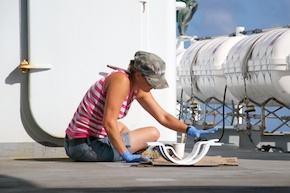
India, the painter (Credit: Will Koeppen)
For the longest time I had thought that India was the painter on the ship as I always came across her with a paint brush and bucket in hand, but it turns out that painting is a task that all of the ABs work on in their respective areas. India had planned on taking me outside to paint the deck, but the rough seas caused a large amount of salt to cover the decks, so she took me down to see the winch room where she was working on another paint job. I was in charge of applying a fresh coat of red paint to a fire axe that is normally stored outside. The job only took a few minutes, but it allowed me the chance to get to know India while working. I learned that she has been an AB for four years and served as the second cook on some cruises. Like many of the crew on board she has been all over the world during her time on ships, both research vessels like the R/V Thompson and fishing boats. When asked which she liked better, research or fishing, she said that the research vessels provided more opportunities to travel to different places, whereas fishing boats usually stuck to the same areas.
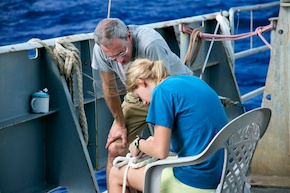
Brian is the knot master (Credit: Will Koeppen)
After I finished painting, India took me out onto the deck to learn how to tie some knots. I had learned some knots during my time at the volunteer fire company in my hometown, but the bowline was still a mystery to me. India quickly remedied my cluelessness and showed me an easy way to remember the knot. Most people learn a story of a rabbit going out of a hole and around a tree, but India is more of a visual person like me. She said that the knot should look as though you were putting a life vest on the rope, and with that hint I was able to tie the knot — with a little help. As I perfected my knot-tying skills I continued to ask about her job as an AB. Throughout the year, India normally works for two months on the ship and then has two months off. The type of shift she works, dayworker (8 a.m. – 4 p.m.) or watchstander (4 hours on, 8 hours off), varies by cruise. When I asked her about her fondest memory during her career, India immediately thought of spending a Christmas in port in Hawaii. The crew had Christmas dinner on board and spent the rest of their time enjoying the beach as well as a barbeque for lunch. Everyone had a good time and enjoyed Christmas even though they were far from home.
India couldn’t help but laugh at my enthusiasm when I finally successfully tied the numerous knots shown to me and said that Brian was the knot master who could probably show me a few more. It was perfect timing since Brian had just come around the corner, string in hand, and he was tying a series of knots related to the story of a sailor who won the hand of his love with his rope skills. When story ended, India left me in Brian’s hands as he had a job with my name on it.
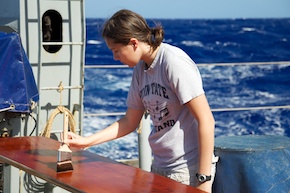
Varnishing the sign (Credit: Will Koeppen)
Well, it wasn’t my name. The R/V Thomas G. Thompson name plaque needed another layer of varnish to protect it from the elements and make it look nice. Brian gave me the brush and bucket, laughing at the parallels to Tom Sawyer painting the white fence. I didn’t mind the work since the sea state had calmed and there wasn’t as much salt water coating the decks. Varnishing the sign only took about 10 minutes, but I had another job waiting, thanks to Will. His prize for winning the TowCam Battery-Life Estimation Pool, a coiled TowCam cable lei, needed to be broken down into smaller pieces so he could fit a piece into his luggage. Brian at first brought out a cable cutter, but it didn’t have enough power to cut through the heavy metal cables. We resorted to using an air-powered grinding tool, which I was a little nervous about when Brian put it into my hands. I was decked out in PPE (personal protective equipment) to prevent any accidents while I worked, but I ended up successfully cutting numerous sections of cable as more and more people wanted a piece of of the cable and JQZ history, including me.
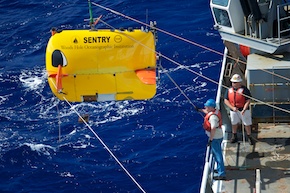
Zeke holds the line (Credit: Will Koeppen)
Once everyone was satisfied with their cable pieces, Brian and I began to clean up our mess, giving me the perfect opportunity to ask a few questions. Brian has been an AB since 1986 and had to think hard about his fondest memory. He has experienced so much during his career that it was hard to pick just one. This wasn’t the first time I had listened to one of Brian’s stories as everyone loves to crowd around when he starts in on a story during meal time or over a game of cards. He told me about a time on the R/V Thompson, working in this area, when a mother and baby whale breached the surface near the ship. He had been working on deck at the time when they breached and it was clear that they had just been feeding. It was a quite a sight, and Brian was one of the few who had gotten to see it.
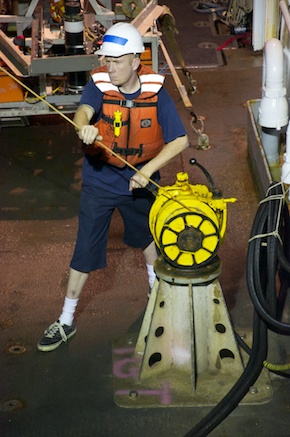
Rob on the winch (Credit: Will Koeppen)
While I didn’t get to spend time with all of the ABs, I have seen the group consisting of Brian, India, Pam, Carlos, Zeke and Rob working around the ship during my time on the R/V Thompson. The job of an AB consists of a lot more than just tying knots, painting, and doing odd jobs. They are responsible for much of the preventative maintenance that makes the R/V Thompson run smoothly. ABs can be found working on the outside of the ship needlegunning to remove rust and painting to help protect the decks and make sure they aren’t slippery. They work indoors as well, making the inside of the ship a safe and clean environment for everyone. During their shifts they can also be found up in the bridge working with mates and making rounds of the ship to keep an eye on things. They are always on deck when deploying and retrieving our scientific equipment, running the winches and cranes, holding lines, and making sure the people and equipment are safe. The ABs are also trained as firefighters in case of emergencies on board. Their schedules keep them quite busy but, like the watchstanders in the lab, they all have ways to relax after a day of work by playing card games, watching movies in the lounge, reading, or enjoying the good weather outside. This group helps keep the ship in running order along with the rest of the crew of the Thompson, and for their hard work I, along with the rest of the science team, am grateful. ♦
